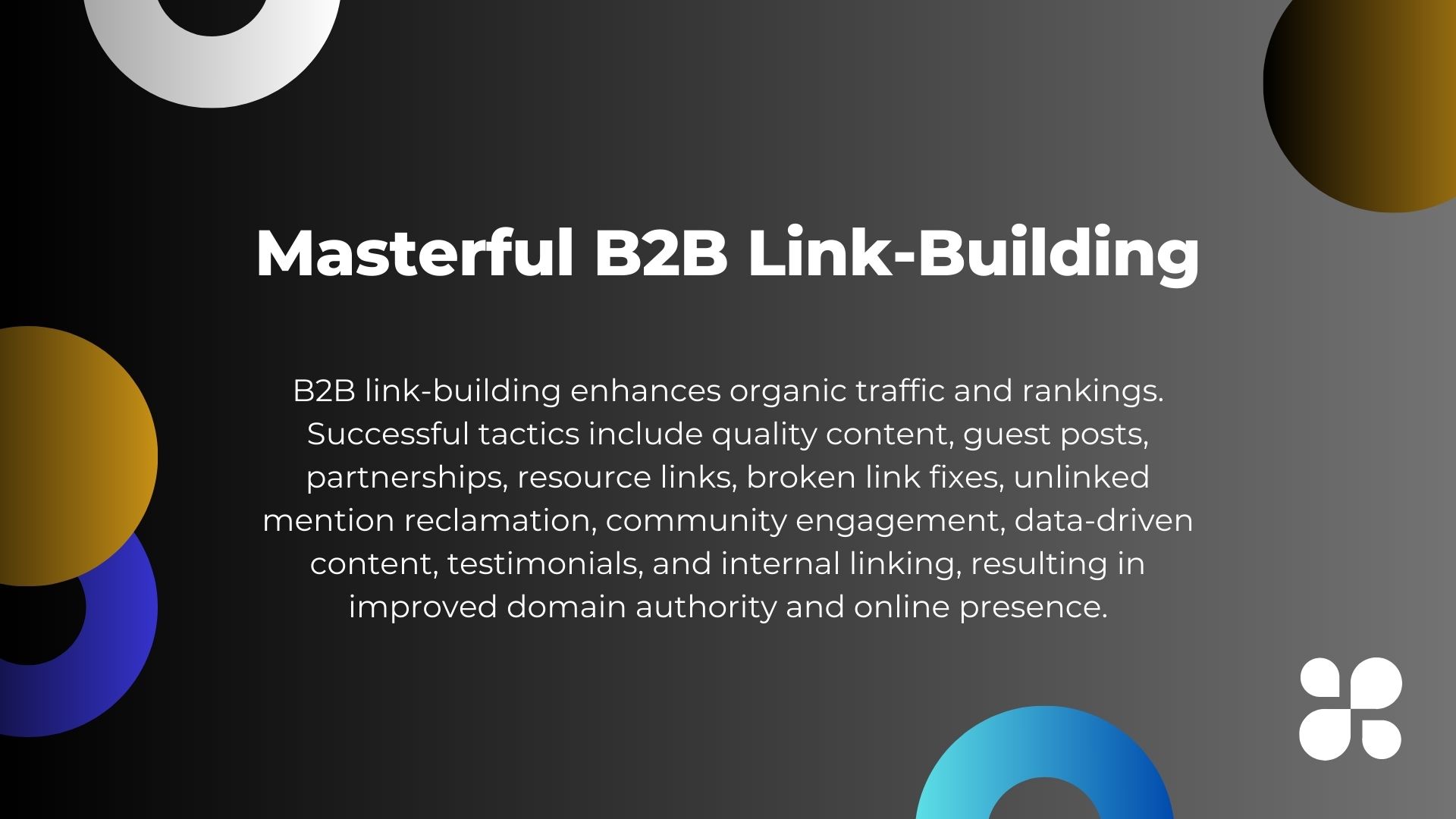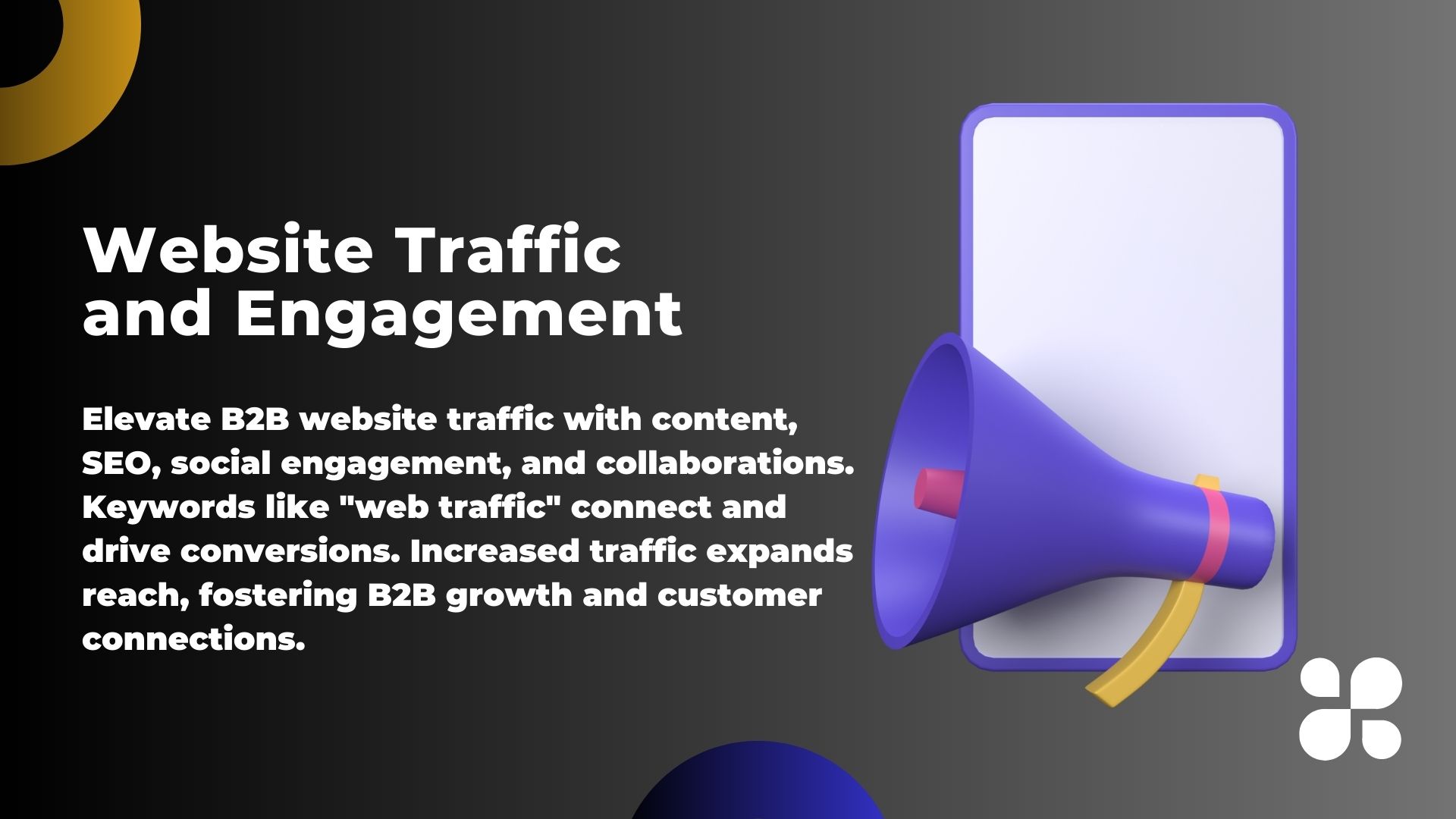Maximize B2B Website Traffic
If you’re running a B2B (business-to-business) website, you know how important it is to have a steady stream of visitors. After all, more visitors mean more chances for potential clients, partners, and growth. Exploring the world of B2B website traffic is like opening a window into how businesses connect online. It’s all about the visitors you get, those potential partners or customers stepping into the virtual corridors of B2B sites. Think of it as a key that can help you understand how B2B companies use their online presence to build relationships and grow. Whether it’s through clever B2B content marketing or other strategies, the goal is to attract and engage, showing that it’s not just about how much traffic you have, but how effectively you connect with those who matter most to your business. So, let’s dive into some easy-to-follow tips on increasing your B2B website traffic and making your digital presence shine!

Enhancing Domain Authority for B2B Success
Imagine establishing a commanding online presence by enhancing domain authority to amplify organic traffic and elevate search rankings. In the B2B realm, pivotal link-building strategies flourish: crafting exceptional content that resonates with your audience and nurturing collaborations through guest posts, partnerships, and resource sharing, all while harnessing the potential of broken link reconstructions, unlinked mentions, and engaging in vibrant industry communities.
Abhishek Shah, The Founder of Testlify, advises, “I understand the significance of building a robust online presence and improving domain authority to drive organic traffic and increase search engine rankings. Link building remains a crucial aspect of any successful SEO strategy, especially in the B2B landscape. Below, I outline some of the most effective B2B link building tactics that have worked well for us:
Create Exceptional Content: High-quality content is the foundation of successful link building. Produce valuable, informative, and unique content that addresses the pain points of your target audience. Such content naturally attracts links from other websites, increasing your domain authority.
Guest Posting and Thought Leadership: Collaborate with reputable B2B publications and websites to publish guest posts and thought leadership articles. Share your expertise and insights to position yourself as an industry leader. These guest posts often include backlinks to your website, boosting your search engine rankings.
Building Relationships and Partnerships: Forge meaningful relationships with other businesses in your industry or related niches. Engage in mutually beneficial partnerships, collaborations, and co-marketing efforts. These partnerships can lead to valuable link placements on partner websites.
Resource Link Building: Create valuable resources, such as ebooks, whitepapers, infographics, and tools, that are relevant to your industry. Outreach to other websites and offer these resources as references or additions to their content, along with a link back to your site.
Broken Link Building: Identify broken links on relevant industry websites and reach out to the site owners with a suggestion to replace the broken link with a link to a similar resource on your website. This tactic provides value to website owners and helps you secure quality backlinks.
Unlinked Mentions: Use tools to monitor brand mentions across the web. When you find instances where your brand is mentioned without a link, reach out to the content creators and kindly request them to link back to your website. This way, you can capitalize on existing mentions and turn them into backlinks.
Participate in Online Communities: Engage actively in online communities, forums, and social media groups relevant to your industry. By providing helpful insights and resources, you can gain recognition as an authority figure, which may lead to other members linking to your content.
Data-Driven Content and Studies: Conduct original research and share data-driven content or studies. This type of content tends to get more attention and is more likely to attract links from other websites seeking to reference reliable data.
Testimonials and Reviews: Offer testimonials or reviews for products or services that you genuinely use and believe in. Some businesses may include a link back to your website when publishing your testimonials.
Internal Linking: Don’t forget about the importance of internal linking. Ensure your website’s pages are well-connected, creating a solid link structure that aids in search engine crawling and helps users navigate your site efficiently.”
Website Metrics for B2B Marketing Strategies
Let’s chat about B2B website metrics – those helpful numbers that show how well your business website is doing. For B2B companies, these metrics are like smart tools that tell us if our marketing plan is working. Imagine your website as a busy store, and these metrics are like friendly detectives counting who’s visiting and what they’re doing. We’re talking about things like conversions (when visitors become customers), and the tracks left by people searching on Google or clicking paid ads. These numbers help us see if our B2B marketing strategies are good. By optimizing your website for organic search and strategically utilizing paid search, you can attract a diverse range of visitors and boost your online visibility. So, as you look at these numbers, keep an eye on how many people become customers, follow those clicks from regular search results and ads you pay for, and use these metrics to make your digital marketing even better.
Crafting B2B Solutions that Speak
Imagine your website as a book in a library. Now, you want people to find your book easily, right? That’s where SEO (Search Engine Optimization) comes in. Using relevant keywords in your content, meta descriptions, and titles can help search engines like Google find your website and show it to people searching for similar topics.
Victor Karpenko, CEO of Seoprofy, advises, “A comprehensive and strategic SEO approach is necessary to enhance organic website traffic and attract additional B2B prospects and potential clients. Here are ten valuable recommendations to accomplish these objectives:
Perform thorough keyword research to identify pertinent B2B search terms, focusing on long-tail keywords that resonate with your target audience’s specific needs and challenges.
Develop valuable and informative content that addresses the concerns and interests of your B2B prospects, investing in long-form articles, whitepapers, case studies, and guides to demonstrate expertise and draw organic traffic.
Optimize on-page SEO elements, including titles, meta descriptions, and headings, by incorporating relevant keywords to enhance search visibility.
Ensure your website is optimized for mobile devices, as B2B decision-makers frequently use smartphones and tablets for vendor research.
Improve your website’s overall user experience (UX) to boost visitor engagement and extend session durations, positively influencing search rankings.
Foster a strong and authoritative backlink profile through link-building endeavors, seeking collaborations with reputable industry websites, publishing guest posts, and promoting valuable content to attract high-quality backlinks.
If your B2B services have a local focus, optimize for local SEO to capture prospects in your target region, including creating a Google My Business listing and maintaining consistent NAP (name, address, phone) information across directories.
Leverage social media platforms to share content, engage with your audience, and raise brand awareness, as social signals can indirectly impact SEO rankings.
Utilize video content to showcase your products, services, and testimonials, as videos often perform well in search results and effectively engage B2B prospects.
Regularly analyze website and SEO performance through tools like Google Analytics, identifying areas for improvement, testing various strategies, and refining your SEO approach based on data-driven insights.”

From Keywords to Conversion Rates
Boosting your B2B website’s traffic doesn’t have to be rocket science. Remember, great content, effective SEO, active social media engagement, and smart collaborations are your weapons of choice. Just like making friends, building website traffic takes time, effort, and a sprinkle of creativity. So, get started, and watch your digital presence flourish!
Driving more traffic to your website is like inviting many visitors to your business’s online doorstep. It’s not just about the numbers, but finding the right key phrases (keywords) like “web traffic” to connect with your target audience. Think of it as the benchmark for your marketing efforts – the more direct traffic you drive to your B2B website, the higher your chances of turning website visitors into valuable customers. Whether it’s through search traffic, direct clicks, or referrals, increasing traffic to your site is a vital metric for B2B firms aiming to boost their conversion rates. So, focus on driving traffic to your B2B website, and watch your business grow as you reach and engage your target audience effectively.
Strategic Content Marketing for B2B Success
Imagine your B2B website as a bustling marketplace where your unique visitors, both from B2B and B2C ( Business-to-Consumer) backgrounds, gather to explore what you offer. Just like a well-planned marketing campaign draws people to your booth, strategic content marketing attracts visitors to your site.
Drive targeted traffic to B2B business as potential clients visit your site through engaging display ads. Imagine this: a steady stream of potential clients, visiting your website each month (Visitors per month), thanks to your efforts in optimizing user experience and driving organic web traffic. This isn’t just about the amount of traffic; it’s about understanding your B2B buyers, connecting with your ideal customers, and fueling lead generation. As you delve into your website analytics, you’ll be able to decipher what’s working, fine-tune your sales and marketing efforts, and watch how your efforts in content marketing drive traffic to your website.
The Mystical Art of B2B Web Traffic
In the realm of B2B web traffic, envision your website as a digital showcase, spotlighting your professional services to potential clients. The visitors you attract, whether through various marketing channels or your well-crafted content marketing strategy, are akin to those strolling through your virtual storefront. It’s like a dance between clicks and engagement, reducing the high bounce rate (Bounce rate is the percentage that measures the rate of visitors leaving a webpage without engaging further), increasing the percentage of visitors who stick around, and enticing them to explore further. With the power of marketing automation, you can thoughtfully guide not only those initial 500 visitors but a multitude more, using personalized touchpoints such as LinkedIn and Twitter. Remember, attracting visitors is just the first part; the real art lies in using this symphony of strategies to not only draw them in but also captivate their interest, forging the path to successfully close the deal and nurture enduring business relationships.
Think of B2B website traffic as a well-crafted strategy where LinkedIn and Twitter act as your partners, working in harmony. It’s like preparing a delicious dish, using a combination of carefully chosen ingredients, like per visit metrics and engaging content about your products or services, to entice the people who visit. Your goal is to make them stay and explore, minimizing that bounce rate, and the percentage of visitors who leave quickly. By understanding what your target audience is searching for, you can effectively share content tailored to their needs, growing your business’s online presence. Imagine each click as an opportunity; aim for visitors to explore at least two pages, helping you identify what resonates. Dive into tools like Google Search Console for insights into how your strategy performs, including those long tail keywords. Just as B2C involves a purchase process, a B2B strategy involves a lot of factors, and mastering this recipe can lead to a satisfying online journey for your potential clients.
